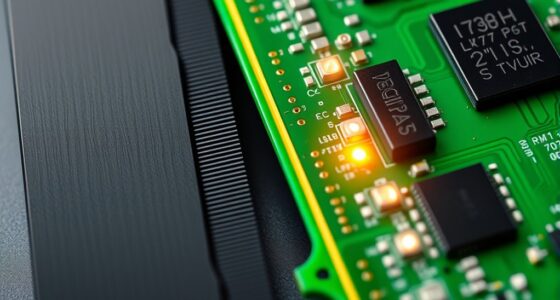The OSI Model is a way to understand how data travels across networks by breaking the process into seven layers. It shows how each layer has specific roles, like formatting data, handling routing, or ensuring error checking. As data moves from your device to the destination, each layer adds or removes information, making sure everything arrives correctly. Keep exploring, and you’ll discover how these layers work together to keep networks running smoothly.
Key Takeaways
- The OSI model divides network communication into seven layers, each with specific functions to facilitate data transfer.
- Data is encapsulated with headers at each layer, ensuring organized and error-checked transmission.
- Protocols like TCP/IP operate within OSI layers to govern data formatting, transmission, and reception.
- During transmission, data signals travel through physical media, then are decoded and decapsulated at the receiver.
- Understanding the OSI model helps beginners grasp how data moves across networks and troubleshoot issues effectively.

Have you ever wondered how different network devices communicate seamlessly? It all comes down to how information is transferred across networks, and the OSI (Open Systems Interconnection) model helps us understand this process. At its core, the OSI model divides network communication into seven distinct layers, each with specific responsibilities. This layered approach ensures that devices created by different manufacturers can work together smoothly. To grasp this better, think about how data moves from one device to another—this process involves various steps, including the use of network protocols and data encapsulation.
Network protocols play a essential role in enabling devices to understand and interpret data. They are sets of rules that govern how data is formatted, transmitted, and received across network layers. For example, protocols like TCP/IP work behind the scenes to ensure that data packets reach their destination accurately. When data is sent, it doesn’t travel as a simple block of information. Instead, it undergoes data encapsulation, a process where each layer of the OSI model adds its own header (and sometimes footer) to the data. This creates a layered envelope, with each layer responsible for specific tasks, such as error checking or addressing. As the data moves down through the layers, these headers build up, providing all the necessary information for the next device to process and forward it correctly.
On the sender’s side, data starts at the top layer and moves downward, getting wrapped in each layer’s protocol information through data encapsulation. When it reaches the physical layer, it’s converted into signals that travel across the network medium—be it cables or wireless signals. When the data reaches the destination, the process reverses. The physical layer hands the signals to the data link layer, which strips off its header, then passes it upward through each layer, each time removing its own encapsulation. This systematic process ensures that the original data arrives intact and understandable. Additionally, understanding the layer-specific responsibilities helps in troubleshooting network issues more effectively.
Understanding how network protocols and data encapsulation work within the OSI model provides clarity on how devices communicate effectively. It highlights the importance of each layer’s role in managing data transmission, error checking, addressing, and routing. Without this layered structure, networks would struggle to support the complexity and diversity of modern communication needs. So, next time you send an email or browse a website, remember the invisible but essential process happening behind the scenes—making sure your data travels safely and correctly across the world.
Frequently Asked Questions
How Does the OSI Model Compare to the Tcp/Ip Model?
You’ll find that the OSI and TCP/IP models differ mainly in layer comparison and structure. The OSI model has seven layers, providing a detailed framework, while TCP/IP has four layers, making it more practical. Model differences include OSI’s focus on standards and TCP/IP’s emphasis on real-world networking. You can use both for understanding networks, but TCP/IP is more widely implemented in actual internet communication.
What Are Common Real-World Examples of Each OSI Layer?
Sure, let’s take a joyride through the OSI layers. At the physical layer, you’ve got Layer-specific devices like hubs and repeaters, making certain bits travel smoothly. The data link layer features switches and MAC addresses, keeping local traffic in check. Network layer’s routers direct traffic, with protocols like IP guiding the way. Transport layer ensures reliable delivery using TCP, while the application layer includes browsers and email clients, making everything user-friendly.
How Does Data Encapsulation Work Across the OSI Layers?
You perform data encapsulation by wrapping your data with each OSI layer’s header as it travels down through the layered communication process. Each layer adds its own information, ensuring proper delivery and interpretation at the destination. This layered approach helps organize and secure your data, making sure it reaches the right application without confusion. When your data reaches the recipient, each layer peels off its header, completing the communication process smoothly.
Why Is the OSI Model Important for Network Troubleshooting?
Think of the OSI model as a map guiding you through complex network issues. It’s essential because it provides protocol standardization, ensuring different devices communicate smoothly. When troubleshooting, layered troubleshooting helps you pinpoint problems at specific layers, saving time and frustration. Without this structured approach, network issues would be like finding a needle in a haystack. The OSI model turns chaos into clarity, making your troubleshooting efforts more effective and efficient.
Are All Network Devices Compliant With the OSI Model?
Not all network devices are fully compliant with the OSI model. Device compatibility varies because many devices prioritize specific functionalities rather than strict standardization compliance. Some hardware and software may only support certain OSI layers, which can cause interoperability issues. To guarantee seamless communication, you should check each device’s compatibility with the OSI model standards and consider how well they adhere to standardization requirements.
Conclusion
Now that you understand the OSI model, you’re better equipped to grasp how data travels across networks. Imagine, every second, over 1.7 billion emails are sent worldwide—each relying on this layered system to arrive safely. By mastering these concepts, you’ve taken a big step toward becoming confident in networking. Keep exploring, and you’ll soon see how these invisible layers keep your digital world running smoothly every day.








